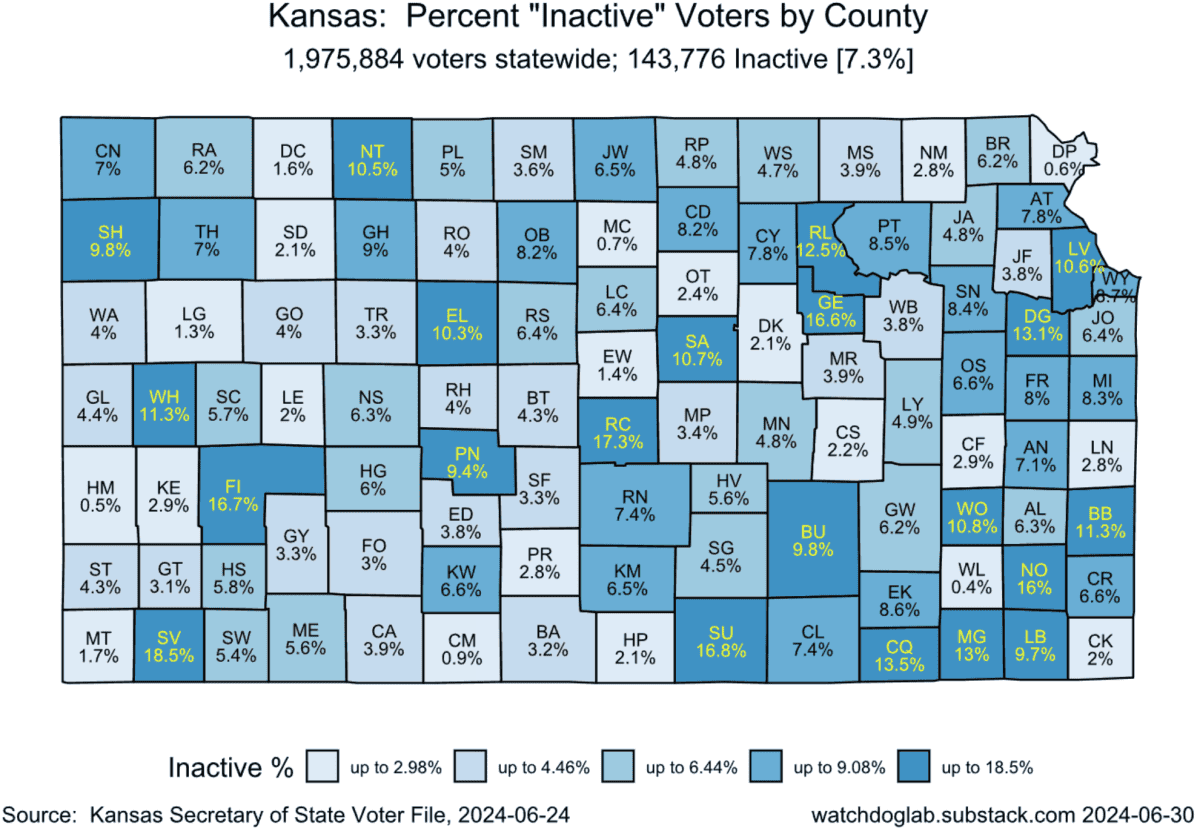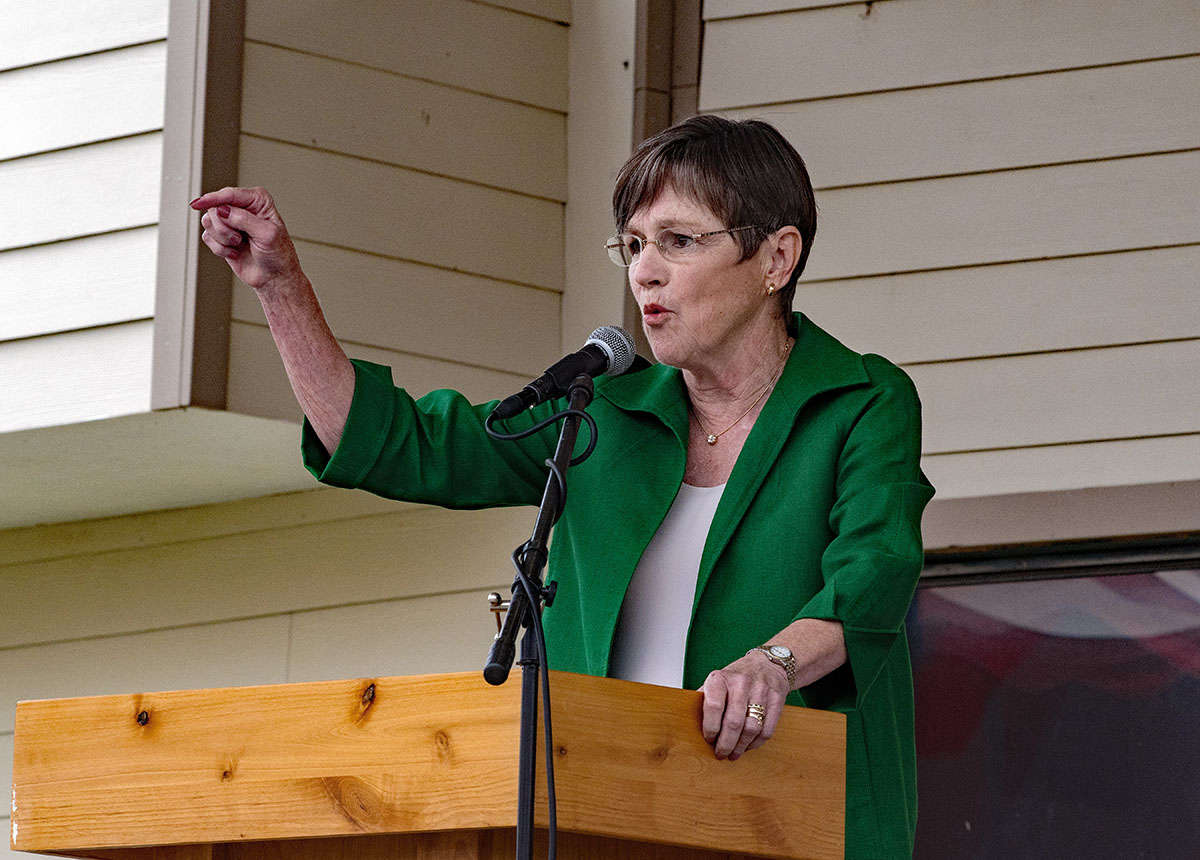With elections approaching, nearly 144,000 Kansas voters are listed as “inactive“, defined in statute as a registered voter who has been mailed a confirmation notice because the voter appears to have moved out of the county and has not responded to the notice and has not voted in any election or otherwise contacted the election office. [KSA 25- 2316c(e)(4)]
That figure represents 7.3% of the nearly 1,976,000 million registered voters in Kansas, and all will appear on their precinct voter rolls and can cast a vote if they appear at the polls. Whitney Temple, Communications Director for Secretary of State Scott Schwab, confirms the inactive voter’s status:
“An inactive voter still remains on the voter rolls. Therefore, their ballot will not be provisional if their address is correct.”

We surveyed several county clerks and election offices to see how they are addressing the inactive voter issue:
Stevens County has the highest percentage of inactive voters in the state at 18.5%. Amy Jo Tharp is County Clerk; she says cooperation from voters is key to reducing inactive rolls:
“We follow the Kansas Election Standards. Last year we did a mass mailing of voter confirmation cards instead of just going off the NCOA (National Change of Address) list in 2023. This probably caused an influx in inactive voter status until we receive their confirmation mail cards back or they go vote.
“People just don’t respond to the mailings we send out, so it’s up to whether they vote or not to determine their status. Some of the confirmation cards with NCOA do come back as undeliverable so our hands are tied at that point as we sometimes have no way to validate or verify addresses/voters, then we have to wait for 2 national/state general elections.”
Hamilton County has seen the sharpest decline in inactive voters this year; now only 0.5% remain. County Clerk Angie Moser has a simple answer for their success:
“Hamilton County follows Kansas Election rules and regulations to reduce the inactive voters of our County.”
Neosho County Clerk Heather Elsworth on her office’s effort to reduce its 16% of inactive voters:
“Our high inactive percentage is due to the amount of voter’s (sic)who appear to have moved out of the county and have not responded to any of the notices that we (Clerk’s office) have sent out. An indicator that the voter may have left the county is shown through undeliverable mailing processes as well as the voter not having voted in any recent elections. We had polling location changes that affected over 5,000 registered voters, which caused a necessary mass mailing of notice of dispositions.
“It is evident that our high percentage is the result of how often we mail out, receive and process notice of dispositions and confirmation mailing cards – all rules and regulations provided to us by the state of Kansas.
“The Neosho County Election Department is following Kansas Election Standards. Chapter 1.”
Comanche County has reduced its inactive rolls to under 1%. County Clerk Casey Houck says it wasn’t easy:
“We work hard to get information out in our papers, Facebook and by word-of-mouth. We almost closed two polling locations but didn’t because of negative feedback and they got out and voted.
“We do a good job by putting flags up to let people know early voting has started. Facebook and our website have become a good source to get more information out.”
Riley County has seen an increase in its inactive list this year. Deputy County Clerk Susan Boller says her county is unique:
“Riley County does have a military base, as well as a private university, state university, and trade school. This does increase our numbers of transient residents.
“We have multiple procedures that enable us to address this. Riley County utilizes the following:
- NCOA (National Change of Address Process)
- County Mailings
- Returned piece of official election mail as undeliverable
- Returned mail ballot or advance voting ballot as undeliverable
- Confirmation Mailings
“These procedures enable us to start the process of making a registrant inactive.
“Once they are inactive, and the voter fails to vote in any election from the date of the confirmation notice through the second succeeding federal general election, we then remove the voter’s name from the registration list.
“My advice would be to utilize all methods advised by the Kansas Election Standards. Utilizing multiple processes will increase your ability to keep your voter registration rolls updated.”
Rice County also had a significant reduction in its inactive roll this year but remains relatively high at 17.3%. County Clerk Aurelia Garcia says interest in this year’s election may help reduce the inactive lists:
“We sent out a mass mailing of confirmation cards that resulted in people returning them with updated information which is not very common. Perhaps due to the type of the upcoming election.
The state’s two largest counties, Johnson and Sedgwick, have relatively low inactive voter percentages: Johnson at 6.4% and Sedgwick at 4.5%. Sedgwick County Election Commissioner Laura Rainwater cited adherence to the Kansas Election Standards for her county’s successful efforts. Johnson County Election Office officials did not respond to our request for comment.
To correct their inactive status, the voter only has to contact their county clerk or election office. However, their voter registration will be canceled if they fail to vote in any election held in the county between the date the notice was mailed and the date of the second subsequent national/state general election.




